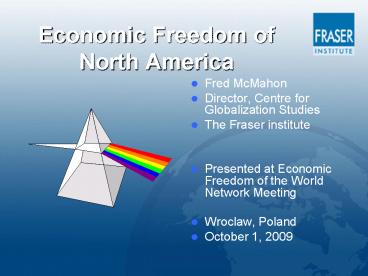Economic Freedom of North America PowerPoint PPT Presentation
1 / 36
Title: Economic Freedom of North America
1
Economic Freedom of North America
- Fred McMahon
- Director, Centre for Globalization Studies
- The Fraser institute
- Presented at Economic Freedom of the World
Network Meeting - Wroclaw, Poland
- October 1, 2009
2
(No Transcript)
3
What is the Economic Freedom of North America
Index?
- An annual compilation of data representing
factors which make a province or state
economically free - A ranking of all US states and Canadian
provinces - A preliminary ranking of Mexican states by Nathan
Ashby, University of Texas at El Paso - Mexico to be integrated into full index in next
two editions - Only third-party, objective data
4
Components of the Economic Freedom of North
AmericaCanada and the United States
- Size of government
- Takings and discriminatory Taxation
- Labour market regulation
- Prepared at both the all-government
- and sub-national level
5
Components of the Economic Freedom of North
AmericaCanada and the United States
- Size of government
- Takings and discriminatory Taxation
- Labour market regulation
- Legal system and property rights
6
The Evolution of Economic Freedom in Canada and
the United States
7
Economic Freedom at the all-government level
Source The Fraser Institute.
8
Economic Freedom at the sub-national level
Source The Fraser Institute.
9
Economic Freedom and Prosperity
10
Economic freedom and per capita Income in the
Canadian provincesCorrelation0.94 out of 1.00
11
Economic freedom and per capita Income in the
Mexican statesCorrelation0.87 out of 1.00
12
Economic freedom and per capita Income in the US
statesCorrelation0.35 out of 1.00
13
Economic freedom and per capita Income in the US
statesCorrelation0.61 out of 1.00
14
Econometric results
15
Economic freedom and GDP
16
Economic freedom and Growth
17
Theme chapterEconomic freedom and entrepreneurs
18
Economic Freedom, entrepreneurship,and Economic
Growth at theby Russell S. Sobel
19
Economic freedom and entrepreneurs
20
Economic Freedom and entrepreneurs
21
Economic freedom and entrepreneurs
22
Economic freedom, income, and poverty
23
New research Economic Freedom and the Economic
Crisis
24
Economic Freedom and the US Policy Response Part
1 by Herb Grubel
- Monetary policy will likely cause inflation,
reducing economic freedom by expropriating
private property though price increases. - Bailout policies involve changes in existing
rules, damaging property rights, the integrity of
the legal system, and the legal enforcement of
contracts. - Other measures, or proposed measures, that will
reduce economic freedom include - higher marginal income tax rates,
- increased regulation of the financial and
manufacturing industries, and - increased regulation related to the cap-and-trade
system.
25
Economic Freedom and the US Policy Response Part
2Spending policies
- The fiscal-stimulus package will likely result in
unprecedented levels of deficits and interest
payments that reduce the amount of credit going
to the private sector. - Federal spending on infrastructure, social
programs, and transfers to the states will
increase government consumption and transfers,
lead to more regulation and, in some cases,
encroach on state responsibilities, damaging the
integrity of the legal system.
26
Economic Freedom and the US Policy Response Some
numbers
- The deficits projected in the budget amount to
6.96 trillion over the 10 years from 2010 to
2019. - Total debt in 2019 will be 15.37 trillion, an
increase of 265 since the end of 2008. - The debt is projected increase from 41 or GDP in
2008 to 67.2 of GDP, above the 60 of GDP, which
EU members may not exceed to remain in good
standing. - The annual deficits are very large 12.3, 8.0,
and 5.9 of GDP from 2009 to 2011, respectively. - The level considered unacceptable under the
Growth and Stability provision of the European
Monetary Union is 3.
27
The Impact of Financial and Economic Crises on
Economic Freedomby Jakob de Haan, Jan-Egbert
Sturm, Eelco Zandberg
- The econometric results for changes in the level
of economic freedom are based on observations at
5-year intervals from 1970 to 2005 for regional
financial crisis, in particular Norway and
Sweden. - The results show that following an economic
crisis economic freedom scores decline. - However, they also suggest that countries that
had a banking crisis in the previous period
increased their level of economic freedom as they
moved into recovery.
28
What did this look like
29
Overall Economic freedom
Crisis most severe in Sweden
Crisis most severe in Norway
30
Size of Government
Crisis most severe in Sweden
Crisis most severe in Norway
31
Legal system and the protection of property rights
Crisis most severe in Sweden
Crisis most severe in Norway
32
Sound Money
Crisis most severe in Sweden
Crisis most severe in Norway
33
Freedom to trade
Crisis most severe in Sweden
Crisis most severe in Norway
34
Regulation
Crisis most severe in Sweden
Crisis most severe in Norway
35
The Impact of Financial and Economic Crises on
Economic Freedomby Jakob de Haan, Jan-Egbert
Sturm, Eelco Zandberg
- However, the authors warn that, due to the global
nature of the current crisis, their results may
underestimate the impact of the crisis on
economic freedom. - In other words, evidence based on previous crises
may not capture the impact of the current crisis
fully. - As most countries in the world are in a serious
economic downturn at the same time, the authors
caution that it will be much harder to get out of
this recession than regional recessions.
36
www.freetheworld.comwww.fraserinstitute.org

